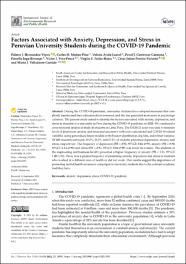Factors Associated with Anxiety, Depression, and Stress in Peruvian University Students during the COVID-19 Pandemic

View/
Download
(application/pdf: 370.3Kb)
(application/pdf: 370.3Kb)
Date
2022-11-07Author(s)
Hernández-Yépez, Palmer J
Muñoz-Pino, Carlos O
Ayala-Laurel, Valeria
Contreras-Carmona, Pavel J
Inga-Berrospi, Fiorella
Vera-Ponce, Víctor J
Failoc-Rojas, Virgilo E
Pereira-Victorio, César Johan
Valladares-Garrido, Mario J
Metadata
Show full item recordAbstract
During the COVID-19 pandemic, university students have adopted measures that completely transformed their educational environment, and this has generated an increase in psychological stress. The present study aimed to identify the factors associated with anxiety, depression, and stress in students at a university in Peru during the COVID-19 pandemic in 2020. We conducted a cross-sectional analytical study in students in Lima, Peru. The DASS-21 scale was used to measure levels of depression, anxiety, and stress and associate it with socio-educational and COVID-19-related variables using generalized linear models with Poisson distribution, log link, and robust variance. Of 400 students surveyed, 19.2%, 23.2% and 17.2% of students presented depression, anxiety, and stress, respectively. The frequency of depression (PR = 0.91, 95%CI: 0.84-0.99), anxiety (PR = 0.90, 95%CI: 0.83-0.99) and stress (PR = 0.92, 95%CI: 0.86-0.99) was lower in women. The students of the engineering and business faculty presented a higher frequency of anxiety (PR = 1.11, 95%CI: 1.00-1.22). There was a greater frequency of presenting anxiety, depression and stress in students who worked in a different area of health or did not work. Our results suggest the importance of promoting mental health awareness campaigns in university students due to the constant academic load they have.
Collections
- Web of Science (WOS) [236]

